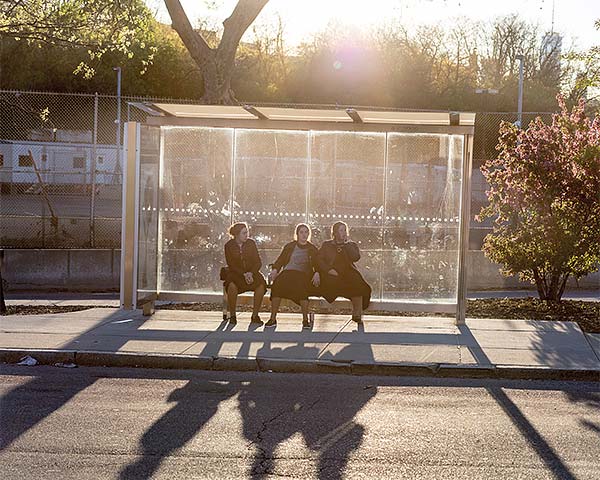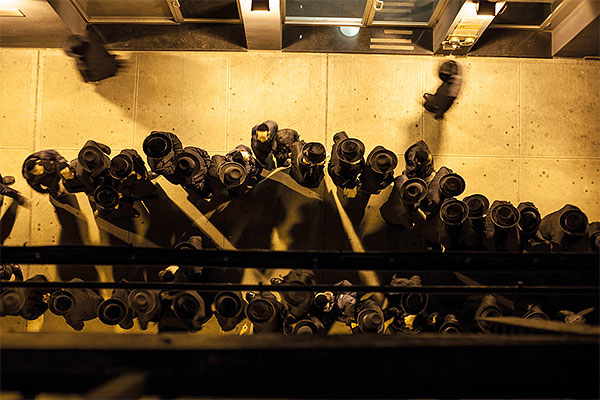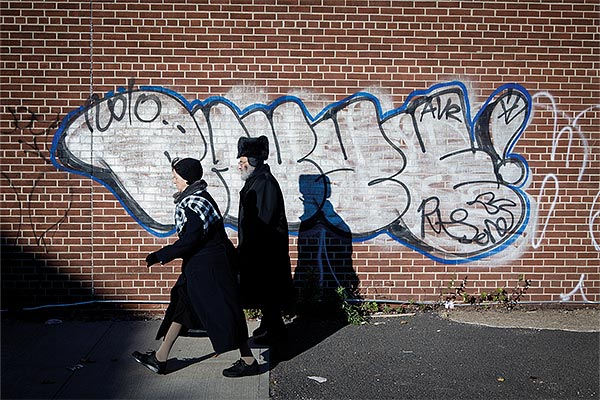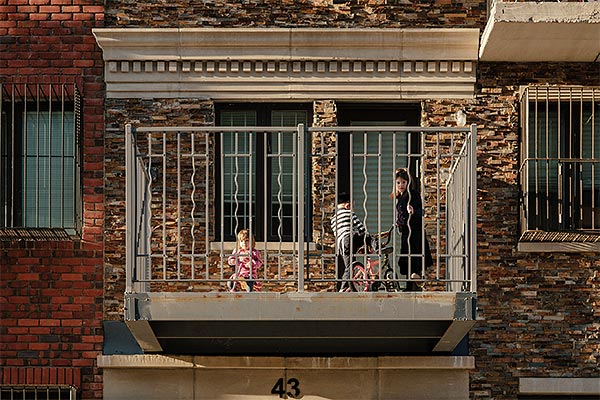Subtotal: $
Checkout-

Spaces for Every Body
-

Poem: “Consider the Shiver”
-

Poem: “No Omen but Awe”
-

Poem: “So Trued to a Roar”
-

Letters from Readers
-

Editors’ Picks: Dirty Work
-

Editors’ Picks: Millennial Nuns
-

Editors’ Picks: Directorate S
-

Letter from Brazil
-

Peace for Korea
-

Flannery O’Connor
-

Covering the Cover: Made Perfect
-

Calling from the Edge
-

The Disability Ratings Game
-

The Way Home
-

The Beginning of Understanding
-

Time for a Story
-

The Island of Misfit Toys
-

A More Christian Approach to Mental Health Challenges
-

Made Perfect
-

Mary’s Song
-

The Art of Disability Parenting
-

When Merit Drives Out Grace
-

Hide and Seek with Providence
-

Unfinished Revolution
-

Falling Down
-

The Hidden Costs of Prenatal Screening
-

The Baby We Kept
-

The World Turned Right-Side Up
-

The Lion’s Mouth
-

How Funerals Differ
-

One Star above All Stars

Stranger in a Strange Land
Even in Brooklyn, our Orthodox Jewish family feels alien. That’s not all bad.
By Kelsey Osgood
January 21, 2022
Next Article:
Explore Other Articles:
On October 27, 2018, I was sitting at our synagogue’s children’s service on Shabbat morning, watching my toddler hug a miniature stuffed Torah, when my husband came into the room and whispered into my ear.
“There’s been a shooting at a shul,” he said. “The security guard is reading the news on his phone downstairs.” This was the massacre at the Tree of Life Synagogue in Pittsburgh.
Our young family had recently relocated back to New York City from London. We’d signed a lease, sight unseen, on a duplex apartment in Brooklyn, only a five-minute walk to the closest Orthodox synagogue. Before we’d lived in London, my husband and I hadn’t had much personal experience with feeling singled out as a result of our faith: we’d become gradually more religious as adults in New York, where it had been easy to forget how much of a minority we were, given the outsized impact on the culture of the city Judaism has had. Our social circle had reacted to our growing religiosity with a sort of benign confusion or indifference, which was usually fine, as we could count on those in our orbit to have at least a passing familiarity with Jewish practice.

Brooklyn’s Williamsburg neighborhood. All photography by Paul McGeiver.
But in London, where we’d amped up our ritual observance and where there are far fewer observant Jews, we’d fielded snide remarks from coworkers, found a lack of kosher restaurants, hiked twenty-five minutes to attend synagogue, which had a constant security presence, and noted passersby on the street staring at my husband’s kippah. We were tired of feeling so isolated, and were anxious to take advantage of the Jewish offerings in Brooklyn, a borough where nearly a quarter of the residents are Jewish. Our new neighborhood was not overwhelmingly Jewish, like the tight-knit Hasidic enclaves nearby, but even still, we figured we were bound to feel far less alone. The day we officially moved in, I climbed up the little ladder onto the tiny roof deck and stood in the frigid night to gaze across at the Statue of Liberty – Emma Lazarus’s “Mother of Exiles”– and listen to the boat horns bellow in the fog, a corny affection for my hometown, whose embrace was wide enough for everyone, swelling in my heart.
The idyll turned out to be mostly mirage. True, it was less of a schlep to get a kosher chicken in Brooklyn Heights than it had been in London’s West End, but we still felt alone. Most of our Jewish neighbors were the type who measured Jewish authenticity by sense of humor and bagel order, rather than by commitment to Torah study or delight in the Sabbath (indeed, for this group, mild disdain for Jewish practice can be taken as a positive sign of Jewishness). Our synagogue was tiny, frequented by a largely older demographic, and not quite aligned with our beliefs as a family; the second closest Orthodox shul was a forty-five-minute trek away. There were moments where I felt like our family was an oddity to be gawked at, such as when local college students would show up at our synagogue hoping to snap photos of our congregation worshiping in order to fulfill a class assignment, or when other parents on the playground would see my son’s kippah (he started wearing one at a younger age than most boys) and make a point of telling me how their little Stephen also did Shabbat at his nursery school. “I’m listening to a podcast on the parsha” (weekly Torah portion), I once heard a mom stage-whisper to her child’s babysitter (on Shabbat, for that matter, when use of electronics is prohibited), clearly for my benefit.
There are ways of convincing yourself you are at home, until the knowledge that you aren’t becomes unavoidable.
Yet these were harmless reminders of our fundamental outsiderness, I figured. Some were even endearing, and they were certainly preferable to apathy or disdain. When the Tree of Life shooting happened, I told myself that it was the work of a madman, no more an indication of the mainstream’s attitude towards me than the Columbine shooters’ actions reflected America’s feelings about teenagers. But there are ways, it turns out, of convincing yourself you are at home, until the knowledge that you aren’t becomes unavoidable.
On the Monday following the shooting, walking with my husband, I saw a swastika, crudely scrawled in yellow chalk on a house on our block.
“Look.”
We stood there in shock, until we noticed a group of our neighbors gathered around a police officer. We learned that a few houses had been vandalized, but no one had seen anything. A detective was on her way. Our neighbors didn’t seem terribly worried: probably pranks in the name of Halloween, they shrugged. One by one, they drifted back indoors. I had to go relieve our babysitter, but my husband stayed behind. He was the only resident there when the detective arrived.
“Well, you’re not a homeowner,” she said, “so why are you so worked up about this?”
My son’s first semi-cognizant Halloween was forty-eight hours away, but that was hardly cheering. Even without the swastika incident, I’d been dreading it. Some decades earlier, a family on our block had given out homemade doughnuts, drawing crowds of people from across Brooklyn. Though the family had long since left, the celebrants still came, forcing the police to shut down the street to traffic. This shouldn’t have incited such handwringing: an all-American hullabaloo bound to entertain my rambunctious child for hours, dropped straight onto my doorstep! And yet the event brought up all sorts of anxiety for me about the life I was preparing my son for. In the religious Jewish world, Halloween is mostly just not done, but both my husband and I had grown up with it and emerged unscathed. Could I just view it as harmless fun? Or did everything in my life have to be about my Judaism? I felt like I was constantly singling out myself and my family as different – no, we can’t eat that meat you just cooked in your non-kosher oven; no, we can’t meet you for Saturday brunch; no, we can’t join your Christmas celebrations – and it was awkward and tiring. I worried constantly that people felt like I was insulting them, or indeed, that I might actually be insulting them. I also worried about what I was teaching my child about the non-Jewish world. Was there ever a case where outlawing things might make them seem more alluring?

I hadn’t yet then heard of the concept I was unwittingly grappling with, that of the ger v’toshav, a person who is both a resident and an alien, or stranger. It’s a phrase Avraham uses to describe himself in the portion of Genesis in which he’s searching for a burial plot for Sarah. “I am (both) an alien and a citizen among you,” he says to the Hittites who surrounded him in Hebron. (In the Torah, “ger” is one of three words that denotes foreigner, and of the three, connotes the most fondness and tolerance. Over the years, it etymologically developed to mean “convert.”)
At first glance, it appears that the two are at odds with one another: how can one be both a citizen and an alien? But while the term eventually evolved to refer to righteous foreigners living within the Israelite nation, it also perfectly encapsulates the precarious position of the Jews, who for centuries have had to engage in a delicate dance of civic participation and cultural rejection in order to be good citizens while also maintaining their identity. It is a dance I engage in every day of my life, on behalf of my children, my family, and myself, one for which I often feel I don’t know the steps at all, but dance it – haltingly, awkwardly, rapidly – I must. Ask me on any given day, and I’ll tell you it is more rewarding than painful, more an act of agency than passivity, more assertive than defensive, more a net good than a loss. On others, I’ll say the opposite.
From some of their earliest moments as a nation following the exodus from Egypt, the Jews were marked by G-d to remain separate: “For you are a people consecrated to the LORD your G-d,” Moshe tells them, using the Hebrew kadosh, which implies both “holy” and “set apart.” At times, this separation is framed as a blessing, bestowed upon the Jews by G-d because of his love for them; elsewhere, it’s suggested that G-d separates the Jews so he can more readily discipline and punish them, the way a father might make an example of his eldest child. Throughout Deuteronomy and Leviticus, the major texts in which Moshe reveals G-d’s laws to the Jews, some precepts are listed that explicitly decry intermingling – “You shall not intermarry with [the other nations]; do not give your daughters to their sons or take their daughters for your sons” – while other laws seem to produce Jewish isolation as a byproduct of adherence, such as those relating to dietary restrictions.
Over the centuries, some thinkers have claimed that separatism protects what is an intrinsic and heritable holiness, which any sustained contact with the non-Jewish world would desecrate or derail. (“The soul of the Gentiles comes from the three klipot: wind, cloud, and fire, all of them evil,” wrote sixteenth-century mystic rabbi Isaac Luria. “So is the case with impure animals, beasts, and birds.”) Others, like the contemporary Orthodox rabbi Nathan Lopes Cardozo, have argued that Biblical separatism was purely instrumental, designed to keep Jews from participating in the barbaric rituals associated with Biblical-era idolatry, such as human sacrifice and orgies. Now that this kind of paganism is virtually nonexistent, Rabbi Cardozo says, laws including the prohibition against drinking wine handled by a Gentile (lest it be used in such rituals) should be modified. This viewpoint is compelling, but viewed by Orthodoxy as a whole as perilous: if we do away with some laws ensuring our survival as a group, then what’s to stop us from discarding them all, thus all but guaranteeing complete assimilation and, ergo, dissolution?
The predominant middle-road view, espoused by thinkers from the Talmudic sage Rabbi Yehoshua to Maimonides to Chief Rabbi Lord Jonathan Sacks, is the spiritual equivalent of separate-but-equal: yes, Jews are different, and yes, their beliefs require some degree of segregation, but it doesn’t mean they are better than others, or that non-Jews are unworthy of G-d’s care and salvation. Indeed, many of this school say, there is ample evidence that Judaism believes all people can live dignified lives and have a place in eternity without sacrificing their own creeds. And yet knowing how separate-but-equal has been applied in other contexts, it’s not hard to see how this rationale might seem unsettling, no matter how beautifully and gently framed.
After the destruction of the Second Temple and the exile from Israel, pilgrimages and burnt offerings were no longer possible; communal prayer and religious study had to suffice. Jewish enclaves in the diaspora formed geographically around synagogues and yeshivas; other institutions vital to Jewish life, like ritual baths and kosher butchers, naturally sprouted up alongside them. A parallel polis, as Czech dissident Vaclav Benda called it, existed alongside the dominant cultures everywhere from Poland to Italy to Yemen, one with its own calendar, legal code, and rituals. To this day, Jews have continued building “a fence around the Torah,” to borrow a popular phrase and concept from the Rabbinic ethics text Pirkei Avot, both to more obviously signal the depth of their piety and as a means of protecting themselves against a hostile world. Jewish law, in the words of twentieth-century rabbi Eliezer Berkovits, became increasingly “defensive”: the prohibition against “round[ing] off the side-growth of your beard” led to the long sidelocks worn by Hasidic men, the seemingly simple instruction to not cook a kid in its mother’s milk became don’t eat at your Gentile neighbor’s house in case she once made chicken parmesan in her oven, and the idea that a non-Jew shouldn’t handle an open bottle of kosher wine lest she secretly sneak some for idolatrous purposes led to a thoroughly embarrassing moment for a friend in the middle of her conversion process: the host of a Shabbat meal tossed a bottle of Cabernet simply because she had glanced at it, despite no law that states a Gentile can contaminate a bottle of wine with a mere look.

Today, if you want to live an Orthodox life, you’ll have to move to a parallel polis, as Orthodox communities remain concentrated because of the prohibition against driving on Shabbat. (The dramatic and ongoing decline of the Conservative movement in America can largely be traced back to its ill-fated decision to rule otherwise, thus inadvertently de-centralizing their communities and undermining their self-proclaimed identity as a law-based denomination.) You’ll secure for your child a religious education, reside within walking distance of a synagogue, shop at kosher stores, fill your shelves with books from Jewish publishers, and so on and so forth. When it comes to exactly how separate one’s polis is, though, there is a pretty wide spectrum. On the liberal end are the Modern Orthodox, like me. We often wear some distinctive garb, keep kosher, and generally reside in clusters, but give our children a secular education and partake of some mainstream culture. On the conservative end, there are the Haredim, who dress far more conspicuously, avoid secular media, and, in the case of Hasidim, speak Yiddish and eschew higher education. They are the stuff separatist dreams are made of. And yet, as ever, the reality is more complex.
When I was in my early twenties, and beginning the slow process of falling in love with Judaism, it was the Haredim I first became enamored with. If I found myself near a visibly Jewish man on the subway, I’d sidle up to peek at the religious text he was poring over on his commute. If I had to meet a friend in the hipster stronghold of Williamsburg, I’d forgo the subway ride in favor of a walk through Hasidic South Williamsburg – anything to feel, for a precious twenty minutes or so, the sensation of being in a space purer than my own, even if it was still just a grimy stretch of city streets. There was a 1988 documentary I watched about a dozen times called A World Apart (an altogether too glowing and simplistic representation of Hasidic life, I later learned) that informed me that all Hasidim were in constant pursuit of dveykus, defined by the narrators as a “mystical state of cleaving to G-d,” a state that could be reached not only by praying but by engaging in nearly any quotidian activity with the right amount of joy and concentration. By that point, I had lived most of my life without any connection to a divine source, following an abrupt rejection of religion at age eight. Walking through the neighborhood, I felt like a starved person watching others feast at a banquet.
Having spent many hours in insular religious environments, both Jewish and not, in the course of writing about religion, I have discovered that I’m far from the only one guilty of romanticizing them. From the Amish to cloistered Catholics, the image of the devoted, isolated religious group often evokes dreamy ideas about authenticity, quality of attention, and wholesomeness, even from some hardened secularists. After all, such things are in short supply in mainstream American culture. And yet the reverie is usually simplistic to the point of delusion. When I tell people, for example, that even in conservative Amish communities, there exists a bordering ecosystem of non-Amish who interact with and in some ways prop up the community – “English” drivers who ferry the Amish around in vans, or visitor guides, or the hordes of tourists who pump money into the local economy – they wonder aloud if allowing another person to drive renders the Amish not “real.” Once, when visiting Sabbathday Lake Shaker Village in Maine, I overheard a guide explain that the Shakers shop at Walmart to a group of visibly disappointed visitors. In that moment, I was instantly reminded of a hypothetical in Walker Percy’s essay “The Loss of the Creature,” part of his 1975 collection, The Message in the Bottle, in which Percy wonders what would happen when an American couple vacationing in Mexico, ecstatic at having discovered the perfect quaint Indigenous village, was confronted with a tribal chief brandishing a Sears catalog.
Nearly a decade ago, a friend and I traveled to New Square, a tiny Hasidic enclave north of New York City, to stay at the home of a local woman over Shabbat. We ate all our meals at the apartment of the fishmonger and watched the tish – a ritual meal in which the rebbe leads the men below in spirited song, sometimes until the wee hours of the morning – through the wooden slats of the women’s balcony above, accompanied by three local teenagers who had taken us under their wings. While I felt rather constrained in my conversation with the local women, who seemed to only be able to discuss household cleaning and food preparation, I could still glimpse the charm of living in a contemporary shtetl, where everyone knew each other, and where the quieter rhythms of life were valued. I could, that is, until our companions smiled wryly and began talking about their clandestine Facebook accounts – something I didn’t even have – and my vision of a standalone world was punctured yet again.
A parallel polis existed alongside the dominant cultures everywhere from Poland to Italy to Yemen, one with its own calendar, legal code, and rituals.
Once I realized that every faith community – from the Satmar Hasidim to the Swartzentruber Amish to the mainline Protestants to the Modern Orthodox – were negotiating the boundaries between tradition and modernity, that no fences constructed of the past were high enough to completely keep out our present, I ceased glorifying these places. I stopped believing that any individual or group could so fully purify their environments that they would not have to grapple with the questions people everywhere are asking of themselves: how much should the wider world intrude into my physical space, and into my soul? True, the more conservative communities might be able to hold off on some fronts for longer, but the world will come for them, too. “Azoy vi es goyisht zich, azoy yiddisht zich,” a friend who grew up in a Hasidic enclave told me her neighbors used to say: roughly translated, it means when the goyish world modernizes, so does the Jewish one. And, of course, when you crave such insularity, you run the danger of letting a desire for ideological consistency harden into a xenophobia that erodes some of the foundational missions of the faith, which include, for Jews, loving and welcoming the stranger, or serving as a light unto the nations.
I couldn’t help but grimace at the reaction of a Colombian pastor who converted to Judaism and emigrated to Israel when he discovered his children were playing with the children of newly arrived Russian families (“most likely they are not Jewish at all,” he balked, even though he himself hadn’t been Jewish until recently). Or laugh, when I saw clips of Haredi revelers at a Jerusalem wedding belting out a tune that had been written specifically for the hit show Shtisel, about a Haredi family in Jerusalem – this, despite the fact that Haredim are said to never watch TV at all.
Underneath my healthy skepticism, I ultimately believe some amount of Jewish separatism is vital to our preservation. My family remained in Brooklyn for two more Halloweens after the swastika incident, although the second one basically didn’t happen because of Covid. At first, I felt like the experience had taught me a valuable lesson about how to help my children understand what it meant to be a minority in America, and solidified for me that there were graceful ways to stand proudly but gently as a visible ger v’toshav in the world. But I eventually came to feel that being conspicuously peculiar, and maintaining a lifestyle that was largely foreign to our neighbors, was more heartache than it was worth. So we relocated to an area of the city that has a much higher concentration of observant Jews. We now live within walking distance of no fewer than five Orthodox synagogues, my son is always one of many children at the local playground wearing a kippah, and his playmates are not bugging him to go trick-or-treating come late October.

The decision to move to a more robust Jewish community wasn’t simply a fleeing from; in a greater sense, it was really a running toward. Because so much of Jewish worship is communal, and happens over the natural course of our days – praying together, eating together, or being present for one another when babies are born and people pass away – living in areas with sparse Jewish populations deprived me of one of my religion’s greatest paths to fulfillment.
I still have non-Jewish neighbors, and our friends here do vary in their levels of religious observance. There is a degree of cultural conformity that I’m unwilling to accept, for myself and for my children. And because I am a convert – an actual ger v’toshav, an outsider both in the Jewish world and the wider one – I would be that much more conspicuous, and viewed much more suspiciously, in a shtetl, no matter how hard I tried to assimilate.
How separatist should a religious Jew be? How do you build fences without building fortresses? I thought of this during this past holiday of Sukkot, during which we eat in small huts outdoors, to remind us of the period the Jews spent wandering the desert post-Exodus. Like many things in Judaism, there are strict requirements for a sukkah: it must be at least three feet tall, have three walls, and the sky must be visible through the roof. Now that we have a backyard of our own, we were finally able to construct a sukkah for the first time. We fitted together the tall metal rods that comprised the “building,” and then unrolled the bamboo sheets atop the scaffolding to make our roof. We were in a rush, as we often are, and so had to forgo the sometimes-elaborate decorations people put up, making do with the ivy spilling over from our garden into the interior as organic décor, and using only a few strips of plastic lattice instead of the tarps many use as walls. At first, I felt like ours looked almost pitifully unfinished.
But then one afternoon, I walked home from shul with my family, greeting the multiple Jewish passersby with a hearty chag sameach – happy holidays – all the while contemplating what it means to live apart but alongside the people on the sidewalk with whom I did not share a lifestyle. As I approached our house, I saw the sukkah in the distance, and realized that it was the answer to my question: a strong, sturdy little hut, designed to withstand the elements, distinct from the space around it, but wide open, as if to say to the strangers looking from outside, “Welcome. Come in.”
Already a subscriber? Sign in
Try 3 months of unlimited access. Start your FREE TRIAL today. Cancel anytime.












































Bill Dale
Very poignant especially after the Texas antisemitic attack...another one........... Thank you